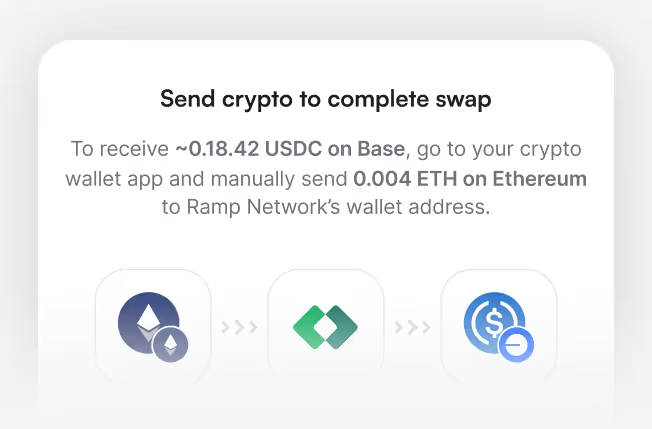


Swap Bitcoin to USDT instantly.
Convert Bitcoin (BTC) for Tether (USDT) quickly and securely with Ramp Network – a simple, step-by-step swap process with no complex bridges, DEXs, or hidden steps.


.svg)










Convert Bitcoin (BTC) for Tether (USDT) quickly and securely with Ramp Network – a simple, step-by-step swap process with no complex bridges, DEXs, or hidden steps.


.svg)







Swapping Bitcoin (BTC) for Tether (USDT) with Ramp Network is fast, secure, and designed to stay simple.

1
Choose Bitcoin (BTC) and Tether (USDT), enter the amount you want to exchange, and review the live conversion rate before proceeding.

2
Sign up using your preferred method and confirm your country of residence to continue.

3
Ramp Network supports both self-custodial wallets like Ledger or MetaMask and custodial exchange accounts. You retain full control of your assets throughout the process.

4
Transfer the BTC from your wallet. Once the transaction is confirmed on the blockchain, the equivalent amount of USDT is sent directly to your selected wallet or exchange account.

Ramp Network supports both self-custodial wallets like Ledger or MetaMask and custodial exchange accounts. When swapping BTC for USDT, simply connect your wallet, review the details, and confirm the transaction.






The swap flow is designed to stay clear and straightforward. Ramp Network avoids unnecessary crypto terminology, making BTC-to-USDT swaps easy even for first-time users.
You remain in complete control of your funds. BTC is sent directly from your wallet, and USDT is delivered to your selected wallet or exchange account.
Ramp Network operates in key regions such as the UK, EU, and US. Supported networks and currencies are displayed during checkout.

Before finalizing your BTC-to-USDT swap, you’ll see a full summary of the transaction, including real-time rates and any applicable fees, so you always know exactly what to expect.
*When compared to transferring via an exchange

When Bitcoin showed up in 2009, it didn’t look like much. Just some code, an idea from someone named Satoshi Nakamoto, and a small group of people curious enough to try it. No one thought it would work the way it did. But it did.
Bitcoin lets people send money to each other without a bank or a middleman. Every transaction is recorded in public, where anyone can check it. There’s no company, no CEO, no one to ask for permission.
The supply is capped at 21 million coins. That’s it. No printing more, no inflation behind the scenes. Because of that, people started calling it “digital gold.” But Bitcoin turned into more than a store of value. It’s now used by freelancers, travelers, small businesses, anyone who needs to move money fast, across borders, with no questions asked.
Nowadays, Bitcoin isn’t a niche idea anymore. It’s just part of how money works online.
Bitcoin (BTC) is the world’s first cryptocurrency, launched in 2009 by the mysterious creator known as Satoshi Nakamoto. Built on blockchain technology, Bitcoin introduced a new way of transferring value online without the need for banks or intermediaries. Its decentralized nature, combined with a fixed supply of 21 million coins, makes it a unique digital asset often referred to as “digital gold.”
Today, Bitcoin is the most recognized and widely used cryptocurrency worldwide. Millions of people use it for trading, investing, and cross-border payments, while businesses across industries accept Bitcoin payments as a secure and transparent alternative to traditional money. Its popularity continues to grow, supported by increasing adoption from financial institutions, mainstream investors, and even governments exploring Bitcoin regulation.
What makes Bitcoin special is its combination of scarcity, security, and decentralization. Unlike fiat currencies that can be printed endlessly, Bitcoin’s supply is limited, creating long-term value potential. Its blockchain is maintained by thousands of nodes across the globe, ensuring transactions remain transparent and resistant to censorship. For many users, Bitcoin represents more than just an investment — it’s a revolutionary step toward financial freedom and the future of money.
The chart displays an indicative, mid-market exchange rate. Effective exchange rate might be different.

Tether, or USDT, was created to make crypto a bit more practical. It’s a stablecoin, which means one token equals about one US dollar. It doesn’t swing in price the way Bitcoin or other coins do, and that’s exactly the point.
USDT first appeared in 2014, before stablecoins became common. People started using it because it made transferring dollars online quick and cheap. No banks, no waiting days for wires to clear. You can send it in minutes, anywhere.
It runs on many blockchains like Ethereum, Tron, and Solana. That makes it fast to use and easy to integrate into apps or exchanges. For many people, it’s a simple bridge between crypto and regular money. You don’t hold it hoping it’ll rise in value. You hold it because it works.
Bitcoin (BTC) is the world’s first cryptocurrency, launched in 2009 by the mysterious creator known as Satoshi Nakamoto. Built on blockchain technology, Bitcoin introduced a new way of transferring value online without the need for banks or intermediaries. Its decentralized nature, combined with a fixed supply of 21 million coins, makes it a unique digital asset often referred to as “digital gold.”
Today, Bitcoin is the most recognized and widely used cryptocurrency worldwide. Millions of people use it for trading, investing, and cross-border payments, while businesses across industries accept Bitcoin payments as a secure and transparent alternative to traditional money. Its popularity continues to grow, supported by increasing adoption from financial institutions, mainstream investors, and even governments exploring Bitcoin regulation.
What makes Bitcoin special is its combination of scarcity, security, and decentralization. Unlike fiat currencies that can be printed endlessly, Bitcoin’s supply is limited, creating long-term value potential. Its blockchain is maintained by thousands of nodes across the globe, ensuring transactions remain transparent and resistant to censorship. For many users, Bitcoin represents more than just an investment — it’s a revolutionary step toward financial freedom and the future of money.
The chart displays an indicative, mid-market exchange rate. Effective exchange rate might be different.
Customers like you have traded over $1 billion in crypto with Ramp Network.